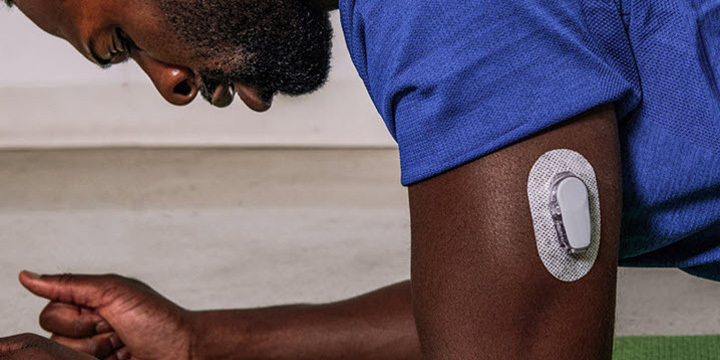
An essential part of diabetes management is knowledge of glucose levels. A medical standard and most-used test for understanding overall glucose control is the A1C measurement, a blood test that provides information on your average blood glucose levels over the past three months.
Another very important part of managing diabetes is the testing that you can do at home. Many people with diabetes take a blood sample from their finger. Traditionally, this has been done by performing a fingerstick at specific times during the day and recording the results in a diary. The home test results can be used to make decisions about food, physical activity or medication to detect or prevent a low glucose level, and to give you a glimpse into your daily glucose levels. Sometimes home test results can reveal a pattern that may be occurring. For example, there might be a specific time of day when your glucose is nearly always in your target range. At another time of day perhaps you are always above or below your target range.
Traditionally finding patterns in your home test results allows both you and your diabetes healthcare team to make longer-term decisions about your diabetes care, such as adding or reducing medications.
However, the fingerstick represents only one second of your day, so even if you measure frequently throughout the day, there can be many missing pieces of the puzzle, especially during the time you sleep.
Recently there have been some changes to how we can measure glucose values that is more convenient and fills in some of the missing puzzle pieces.
What is continuous glucose monitoring?
A continuous glucose monitoring (CGM) system is exactly what it sounds like. A small wearable sensor is inserted just under your skin and continuously measures the glucose level. You can see the most recent glucose reading on a receiver or compatible smart phone. Compared with a fingerstick that reports the glucose level for that moment in time, a continuous glucose sensor can provide a new reading every 1-5 minutes (varies by system), and lets you know if glucose levels are trending up or down.
What should I know about continuous glucose monitoring?
Let’s talk about the sensor. Many Canadians living with diabetes use a CGM system. The sensor, which includes a small filament (looks like a hair) is inserted under the skin using an applicator. This allows the sensor to measure glucose in what is called the interstitial fluid.
Glucose readings in the interstitial fluid may be slightly different from a fingerstick reading that measures glucose in your blood. Both fingerstick readings and interstitial fluid readings are considered accurate when compared to a glucose level measured in a laboratory, but without the trip to the lab and the doctor’s visit to find out the result.
One of the best things about CGM is many people find inserting the sensor to be easy and painless, especially when compared to performing routine fingersticks.
Depending on the brand, a glucose sensor can last from 6 to up to 14 days. While you are wearing a CGM sensor you will be able to see your glucose reading whenever you wish. Depending on the brand you can either manually scan the sensor with a compatible smart phone, called ‘intermittently-scanned CGM’ (isCGM), or use a sensor system where glucose readings automatically transfer to a compatible smart phone and can be seen at a glance, called ‘real-time CGM’ (rtCGM). For people who don’t want to use a smart phone, a compatible reader (or receiver) is often available as an option.
The CGM system can not only report your glucose level, it can also display a trend arrow to indicate where glucose is going and how quickly levels are changing. Trend arrows point ‘down’ to tell you glucose is dropping and ‘up’ to tell you glucose is rising. Trend arrows can be used to help you prevent low glucose events or reduce high glucose levels. With traditional fingersticks, you can know where glucose is at the moment the test was done, but you do not know if your glucose levels are trending high or low, or if a low glucose event might be imminent.
Depending on the brand, CGM systems also have options you can set to alert you of low or high glucose. You can often customize the glucose level you want to be alerted at. Some brands even have a predictive low glucose alert that can warn you of a predicted low glucose event in the immediate future.
CGM users can also see how much time their glucose is within their desired target range. This metric, called ‘time in range’ (TIR), is quickly becoming an important metric in diabetes care that is supplementary to the A1C test. Many healthcare providers work with people with diabetes to help them increase their time in range and find ways to reduce time spent above or below their target range.
Is continuous glucose monitoring right for me?
If you or your healthcare team think you would benefit from knowing more about your glucose levels, continuous glucose monitoring might be right for you!



